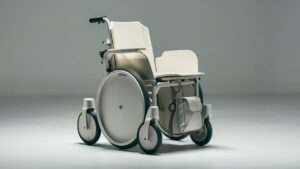The stethoscope was invented by French physician René Laennec in 1816. He created it by rolling a paper tube to amplify heart sounds.
The stethoscope is a vital tool in modern medicine, allowing healthcare professionals to listen to internal body sounds. Before its invention, doctors relied on direct contact to assess heart and lung conditions. Laennec’s innovation marked a significant advancement in patient examination techniques.
His simple yet effective design laid the foundation for the stethoscopes we use today. Over the years, this instrument has evolved, incorporating advanced technology to enhance sound quality and diagnostic capabilities. Understanding its history helps appreciate the profound impact the stethoscope has had on medical practice and patient care throughout the years.
The Birth Of The Stethoscope
The first stethoscope was invented by Rene Laennec, a French doctor. He created it in 1816 to help listen to patients’ hearts. Laennec’s first model was a simple rolled paper tube. This clever design acted as a funnel, allowing him to hear sounds better. Doctors at that time needed a way to listen to internal body sounds without being too close. Laennec’s method was a major advancement in medical practice.
His invention soon gained popularity among other physicians. The stethoscope changed how doctors examined patients. Listening to the heart and lungs became easier and more effective. This simple tool laid the foundation for future advancements in medical technology. Today, stethoscopes are essential instruments in healthcare.
The Pre-stethoscope Era
Before the stethoscope, doctors used various listening practices to examine patients. They often placed their ears directly on the patient’s chest. This method made it hard to hear internal sounds properly. Overcrowded hospitals and loud environments made it even more difficult.
Another common practice involved using a hollow tube to amplify sounds. This method was not very effective. Doctors could still miss important heartbeats or breath sounds. The absence of modern technology limited their understanding of diagnostic signs.
Overall, these early methods lacked accuracy. They didn’t provide a clear picture of a patient’s health status. The need for a better solution led to the invention of the stethoscope.
The Purpose Unveiled
The stethoscope was invented to help doctors hear internal sounds in the body. This device amplifies sounds from the heart, lungs, and bowels. Before its invention, doctors used their ears alone to listen. They struggled to hear faint sounds and often missed important details.
Rene Laennec, a French doctor, created the first stethoscope in 1816. He rolled up a paper tube to funnel sounds from a patient’s chest to his ear. This simple idea marked a diagnostic breakthrough in medicine.
Over the years, the stethoscope has evolved significantly. New technology has improved how doctors listen and what they can detect. Today, it remains a vital tool in healthcare, helping to save lives.
Evolution Over The Decades
The stethoscope has undergone significant changes since its invention. The first model was monaural, made of a simple tube. This early version was invented by René Laennec in 1816. It helped doctors listen to heartbeats and lungs more clearly. Over time, the design evolved into the binaural version. This newer design allows doctors to listen with both ears, enhancing sound quality.
Technological advancements have improved stethoscopes further. Modern stethoscopes often include features like acoustic enhancement and digital technology. These innovations help detect subtle sounds. As a result, doctors can make better diagnoses. The evolution of the stethoscope reflects the growing complexity of medical technology.
The First Stethoscope’s Anatomy
The first stethoscope, invented by René Laennec in 1816, was quite simple. It was made from a rolled-up paper tube. This design allowed doctors to hear heart sounds better by funneling sound from the patient’s chest. Doctors used it to detect problems in the heart and lungs.
Modern stethoscopes are very different. They have two earpieces and a chest piece with a diaphragm. This design helps amplify sounds more effectively. Some even include digital technology, which records sounds for better analysis. Today’s stethoscopes are lighter and more comfortable than the original.
While the first stethoscope was basic, it paved the way for advanced medical tools. The design has changed, but the goal remains the same: to help doctors listen to what’s happening inside the body.
Societal Impact Of The Stethoscope
The stethoscope changed the way doctors understand patient health. It allowed doctors to listen to internal sounds like the heart and lungs. This tool made it easier to diagnose illnesses accurately. Before the stethoscope, doctors relied on touch and sight. The invention marked a significant shift in medical practice.
Its cultural significance is immense. The stethoscope became a symbol of the medical profession. It represents the trust between doctors and patients. As it evolved, so did the methods of examination. This led to better patient care and outcomes.
Modern Developments
Modern stethoscopes have seen remarkable advancements. The leap into electronic stethoscopes transformed how doctors diagnose patients. These devices use microphones to capture sounds more clearly. They amplify heartbeats and lung sounds with better accuracy. This technology allows for data storage and analysis, improving patient care.
The future of auscultation looks bright. New innovations include wireless stethoscopes that connect to smartphones. These devices enable remote consultations between doctors and patients. As technology progresses, stethoscopes will become even more sophisticated. Doctors will have access to real-time data, making diagnoses quicker and more precise.

Stethoscope Through The Centuries
The stethoscope has a rich history. Its invention marked a major change in medicine. In 1816, French doctor Rene Laennec created the first stethoscope. He used a rolled-up paper tube to listen to heart sounds. This simple design quickly became popular among doctors.
In the following decades, the stethoscope underwent significant changes. Binaural designs emerged, allowing doctors to listen with both ears. The modern stethoscope appeared in the late 19th century. It featured a chest piece, flexible tubing, and two earpieces.
Today, the stethoscope is vital in healthcare. It helps doctors examine the heart, lungs, and other organs. Technological advancements have enhanced its capabilities. New models now include digital features for better sound quality. The stethoscope remains a symbol of the medical profession.
Practical Uses Across Specialties
The stethoscope serves crucial roles in cardiology and various medical fields. It helps doctors listen to heartbeats and lung sounds. This tool is essential for diagnosing many heart conditions.
Beyond cardiology, the stethoscope is used in pediatrics, internal medicine, and emergency care. It allows healthcare providers to assess patients quickly. This tool is vital for training new doctors and medical students.
Students learn how to identify normal and abnormal sounds. Using a stethoscope enhances their hands-on skills. It builds confidence in evaluating patient health effectively.
Celebrating The Stethoscope
The stethoscope is a vital tool in medicine. It helps doctors listen to the body’s sounds. World recognition for the stethoscope began as it changed healthcare forever. Stethoscope Day celebrates this important invention every year.
In popular culture, the stethoscope symbolizes medical professionals. Movies often show doctors with a stethoscope around their necks. This simple device represents care and expertise. Its image evokes trust in patients.
Many people recognize the stethoscope as a sign of health. It is not just a tool; it is a cultural icon. The stethoscope plays a key role in how we view medicine today.
Frequently Asked Questions
Who Invented The Stethoscope And Why?
Rene Laennec, a French doctor, invented the stethoscope in 1816. He created it to amplify heart sounds, improving diagnostic capabilities. Initially, he used a rolled paper tube to funnel sound from a patient’s chest. This innovation significantly advanced medical examination practices.
How Did Doctors Listen To Heart Sounds Before The Stethoscope Was Invented?
Before the stethoscope, doctors used their ears directly on patients’ chests. They also employed simple devices like rolled paper tubes to amplify sounds. This method allowed them to detect heartbeats and other internal sounds. These techniques were essential for early diagnoses before modern instruments became available.
What Was The Purpose Of The Stethoscope?
The stethoscope amplifies internal body sounds, allowing doctors to assess the heart, lungs, and digestive system. It helps identify abnormalities by listening to these sounds, crucial for accurate diagnoses. Since its invention, the stethoscope has evolved, enhancing its effectiveness in patient care.
How Did The Stethoscope Evolve?
The stethoscope evolved from a simple paper tube used by René Laennec in 1816. It transformed into a binaural design, enhancing sound quality. Modern advancements include electronic stethoscopes, improving diagnostics further. This evolution reflects ongoing innovations in medical technology and practice.
Conclusion
The invention of the stethoscope marked a significant leap in medical diagnostics. René Laennec’s simple yet innovative approach transformed how doctors assess heart and lung health. Today’s stethoscopes are technologically advanced, yet they carry the legacy of that first rolled tube.
Understanding this history enriches our appreciation for modern medicine and its tools.








